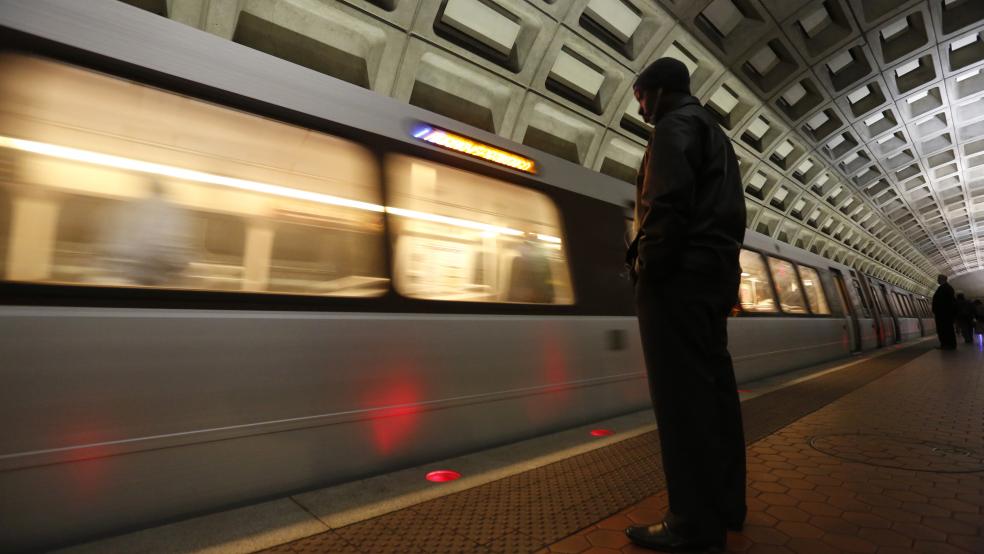It is barely four days since the upset election of a Republican governor in the usually-blue state of Maryland, and pressure is already building on Larry Hogan to break his campaign promises to put the Free State on a fiscally responsible path.
Friday’s Washington Post called for Hogan to approve the Purple Line, a 16-mile light rail project just north of Washington D.C. that is anticipated to cost $2.5 billion. If Hogan approved the project, he would break faith with the voters who elected him to the surprise of the nation and the pollsters.
Related: Post-Election Bipartisanship Fails First Media Test
There is no quicker way for Hogan to destroy his reputation than to approve the costly Purple Line. Maryland has funding for roads, but not for inefficient light rail. In September Hogan said, "We're going to focus on building roads, and that's something this administration has not done."
The Purple Line’s $2.5 billion projected price tag, as well as about $58 million a year for maintenance, is likely to understate the actual cost. The rail line is not projected to cover its operating costs, let alone its construction costs, because no riders want to pay for it. As with all major publicly-funded transportation projects, the Maryland Transit Authority releases new cost estimates every few months, and those estimates go only one way – up.
MDTA proposes to obtain $900 million in grants from the federal Department of Transportation and an additional $732 million in federal loans. The state share would be $726 million, plus repayment of the $732 million loans, adding up to $1.5 billion. None of the federal funds have yet been approved. The new 114th Republican Congress, which has promised to break with its predecessors and pass annual budgets, might be less willing to pony up $900 million than the 113th.
The Purple Line would connect New Carrollton in Prince George’s County and Bethesda in Montgomery County. This could be accomplished at a fraction of the cost with dedicated bus lanes along existing roads, or by widening roads. These buses could then fan out to alternative locations within the two counties. Dedicated buses utilize already-existing infrastructure and also reduce traffic congestion.
Related: Obama, McConnell, Boehner - Wise Up for America
Unless people were going directly from New Carrollton to Bethesda, or vice versa, people would have to get off the metro and on to the Purple Line train, and then connect to another metro or bus afterwards to reach their final destination. This would be time consuming, as well as cumbersome, especially for people with groceries and children. Most people would rather drive. When time for train transfers and regularly-occurring delays are added to estimates of Purple Line travel time, the benefits of buses or cars become even greater.
The Washington Post says that the Purple Line would “appeal to young, creative professionals.” But young professionals are busy and value their time. Only those that live in Bethesda and work in New Carrollton, or vice versa, would find it useful. Others would take the existing metro or drive.
The difficulty of using the extra light rail line is one reason that the Maryland Transit Authority estimates that only 11,800 new riders in 2040 will use the system, according to a July 2014 MDTA unpublished estimate, which I reviewed.
Although 11,800 new riders sounds like a large number, it is less than 1 percent of projected daily ridership in the Washington Metropolitan area in 2040. The $2.5 billion cost adds up to over $211,000 per rider. For the cost of the Purple Line, each additional rider could have four new Mercedes-Benz E-Class sedans at $52,000 each.
Related: N.J. Rail Nightmare - A Sign of the Infrastructure Crisis to Come
In addition, the Purple Line would destroy a popular bicycle path that runs along the same route. Environmentalists have sued to block the project because it would harm small creatures known as amphipods. Even if the project were costless to Maryland taxpayers, it is vastly unpopular among many groups of people.
The Purple Line is aptly named because Marylanders are purple with outrage at the waste of money. The wasteful project, as well as a proposed $2.6 billion Red Line light rail line in Baltimore and Baltimore County, contributed to Hogan’s election. Even Baltimore County, home of traditional blue-collar Democrats, voted for the Republican by a 19-point margin. Residents are tired of higher taxes and costly, inefficient infrastructure projects, and they want leadership that will take a different tack—as Hogan promised to do.
Under Democratic Governor Martin O'Malley, elected in 2006 and re-elected in 2010, Marylanders have seen over forty separate tax increases. The Free State even has a "rain tax" on impervious property: owners are charged for any nonabsorbent surface on their land.
Tax hikes may make life more difficult for millions of Marylanders, but they have not done much to reduce Maryland's $9 billion structural deficit.
Related: Republicans Dominate Governors' Races
Over the past five years, Maryland has lost multinationals such as Coventry Health Care, Black & Decker, and Constellation Energy. When corporations relocate to the D.C. metropolitan area, they frequently choose Virginia, such as Volkswagen (2007), Hilton Hotels (2009), and Northrop Grumman (2010). In September 2014, the latest data available, Maryland's unemployment rate was 6.3 percent and Virginia's was 5.5 percent.
The Washington Post writes that the Purple Line would create jobs, especially from “construction and engineering giants that have bid on the project.” But this ignores the negative effects on employment of the higher taxes paid by Maryland residents. Under Governor O’Malley, tax and spend policies have not brought Maryland prosperity—which is why his designated heir, Lieutenant Governor Andres Brown, lost the election.
On Election Day, Marylanders wisely voted to safeguard for transportation all revenues in the Maryland Transportation Trust Fund. With transportation tax dollars now protected from raids by the state’s general fund, Maryland is solidifying the relationship between those who pay for transportation and those who use it. Rather than wasting money on costly white elephants, Maryland should improve its roads.
Diana Furchtgott-Roth, former chief economist of the U.S. Department of Labor, directs Economics21 at the Manhattan Institute, where this opinion piece originally appeared. You can follow her on Twitter here.
Read more at E21:
Stop Worrying About Deflation
Here's the New Congress' Most Important Task
Minimum Wage on the Election Day Ballot



